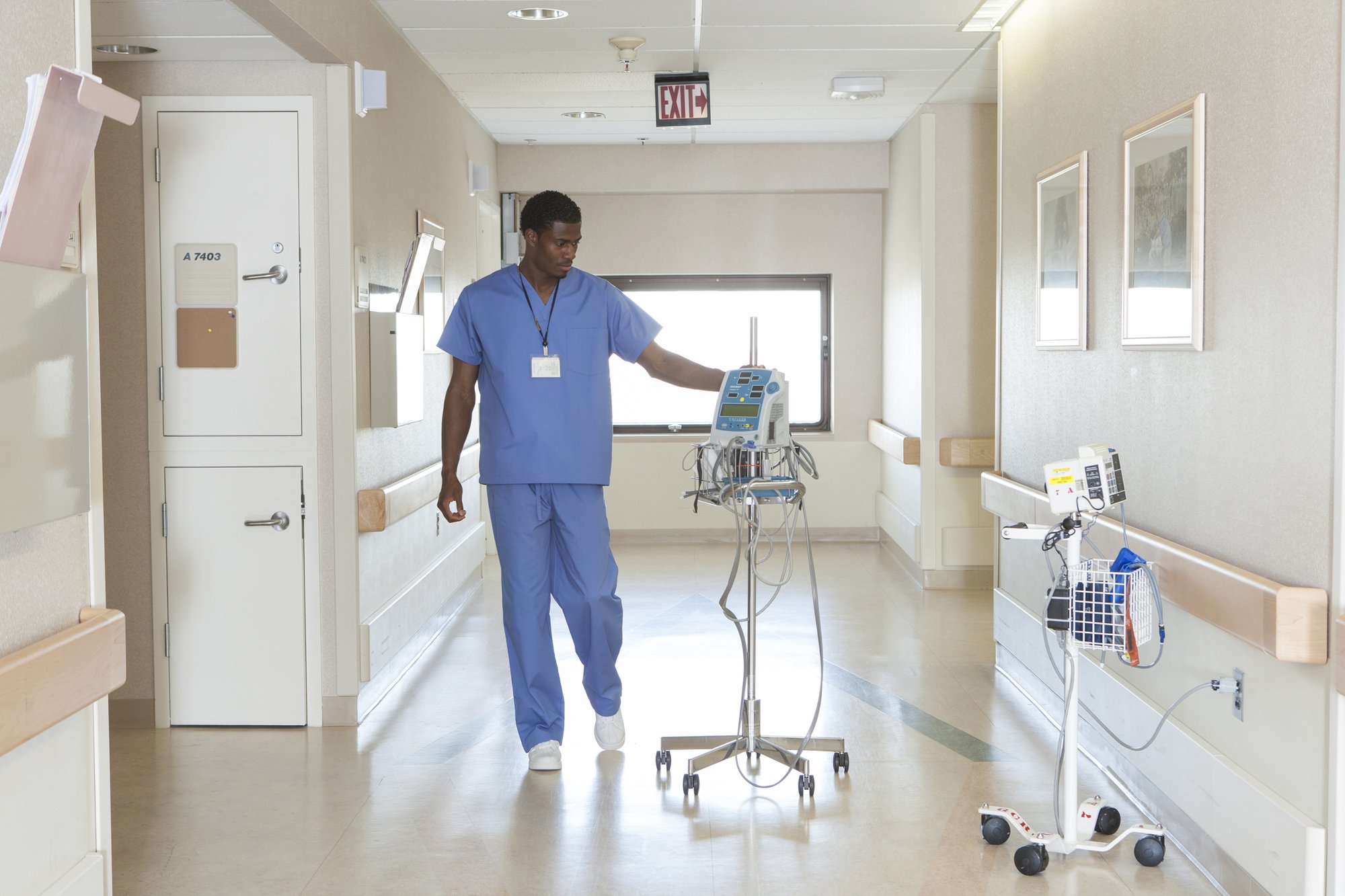Is There a Nursing Shortage in the US? Statistics by State

The US is projected to face shortages in nursing staff in short and long terms, both at national and state levels, with the worst nursing shortage being seen in Georgia, California and Washington. North Dakota, South Dakota and Utah are the first three states by rate where staff numbers surpass the demand. Shortages are higher in non-metropolitan and rural areas, than in metropolitan, urban or suburban areas.
Nursing has always been associated more with a vocation than a profession. However, the industry has enough so that, according to the Bureau of Labor Statistics (BLS), nurses now represent over 50% of the health workforce and are crucial to the entire healthcare industry in the United States. According to the latest occupational statistics, 7 out of the 20 fastest-growing occupations are in the nursing industry. The BLS also reports that nursing roles also top the list of occupations projected to see the highest net increase in new jobs by 2032.
Although the statistics suggest continued growth in employment, health professionals, administrations, and communities must tackle all the contributing factors relating to the nursing shortage to actually meet these projections.
Let’s find out which US states suffer the most, what the causes are, and what the solutions are.

National Nursing Shortage Statistics
For starters, it’s worth clarifying whether there is a nursing shortage in the US in 2024. In short, there is, and there isn’t, since shortage rates are dependent on nursing specializations.
According to the Health Resources and Services Administration (HRSA) Nurse Workforce Projections: 2026-2031 report issued in March 2024, the US is projected to see shortages of licensed practical nurses and registered nurses but not for the different specializations of nurse practitioners.
On a national level, the projected supply of nursing staff for 2026 will account for 93.43% of the demand. The highest level of nursing shortage is seen for RNs, followed by LPNs, while for nurse practitioners, the staff supply surpasses demand by an extra 32%.
Here are the nursing shortage statistics for 2026:
- Registered nurses – 10% shortage, equivalent to 350,540 unoccupied positions
- Licensed practical nurses – 7% shortage, equivalent to 46,920 unoccupied positions
- Nurse practitioners – 32% surplus, equivalent to an excess of 100,620 NPs
- Nurse Anesthetists – 5% surplus, equivalent to an excess of 2,660 anesthetists
- Nurse midwives – 5% surplus, equivalent to an excess of 570 midwives
The shortage of nursing staff can also translate into increased demand and, consequently, a better job outlook for RNs and LPNs. If you want to capitalize on the current opportunity, our guide on how to become a licensed practical nurse might help you. But if your goal is to obtain your RN licensure, you’ll find everything you need to know from our articles on how to get an ADN or how to earn a BSN degree.
If you want to complete your education in a way that accommodates your personal routine and needs, you can choose the hybrid programs provided by Nightingale College.
- The 12-month PN Diploma Program includes the online instruction and on-ground supervised field practice necessary to take the NCLEX-PN and become a licensed practical nurse.
- The BSN Program is a 3-year flexible learning option that focuses on concept-based theory, intervention skill-based, case-based preparation, and direct-focused client care to prepare you to sit the NCLEX-RN.
- If you already are an LPN and want to advance to the RN position, we provide a 16-month fast track via the LPN-to-ASN program that prepares you for the NCLEX-RN.
However, if you want to increase your job opportunities as an RN, you can earn your BSN by learning with our 100% online RN-to-BSN track, which you can complete in as few as 12 months.
Nursing Shortage by State: Which Regions Suffer the Most?
According to the comprehensive HRSA report on Nurse Workforce Projections, there are major differences across states regarding the projected number of RNs for 2036 (the numbers are calculated for full-time equivalent).
You can use the map below to find the nursing shortage rate for each US state:
It is worth noticing how the almost four million registered nurses are dispersed differently throughout the US. There are entire regions with a surplus of RNs along with cities where job growth remains high just because the number of nurses there can barely meet the community's basic medical needs.
States with the Highest Nursing Shortage
Here is the list of states projected to have the highest nursing shortage rate in 2036, along with their associated deficit percentage for registered nurses:
- Georgia (29%)
- California (26%)
- Washington (26%)
- New Jersey (25%)
- North Carolina (23%)
- New Hampshire (23%)
When judging by absolute numbers, the highest number of nurses needed by each state the ranking order changes drastically:
- California (projected net deficit of 106,310 RNs
- Georgia, (net deficit of 34,800 RNs)
- Texas (net deficit of 32,100 RNs)
- North Carolina (net deficit of 31,350 RNs)
- New Jersey (net deficit of 24,450 RNs)
Overall, US states in the South are most affected by the current nursing shortage, with an average shortage rate of 8.39% and a net deficit of 258,780 nurses. The nation’s West comes next with a 8.22% shortage rate and a 33,430 net deficit.
States with the Lowest Nursing Shortage
At the opposite pole, among the states with the lowest net nursing shortage are the Vermont, with an estimated shortage of just 230 RNs for 2036, followed by West Virginia (estimated shortage of 250 RNs), Mississippi (also falling 320 RNs short of meeting the demand) and Maine (with 390 fewer nurses than its demand). Ranked by the percentage of occupancy for nurses, Pennsylvania (over 99%) comes first, followed by Alaska (over 97%), Florida (under 97%), Montana (under 97%) and Illinois (just under 95%).
There are also states with no projected nursing shortage by 2036. North Dakota is expected to have an excess of 3,550 RNs over its demand, amounting to a staff surplus of 42%. South Dakota will have 4,020 more RNs than required, meaning a 39.6% staff surplus. Utah will also have 6,180 more RNs than required, the equivalent of a 17% surplus, followed by Minnesota with 10,520 extra RNs, which is equivalent to a 16.5% surplus.
In general, the Northeast has the lowest nursing shortage rate (6.60%), but with a slightly higher net deficit of 36,510 nurses. However, the Midwest is the only region with a surplus of nurses, having a 7.36% excess, which is equivalent to 7,050 extra nurses.
Projected Nursing Shortage by State (2036)
Below is a complete list of US states with nursing shortages and those with a surplus of registered nurses:
| State | Supply of Registered Nurses | Demand for Registered Nurses | Nursing Shortage Percentage | Net Nursing Staff Shortages |
| Alabama | 64,250 | 59,760 | -8% | 4,490 surplus |
| Alaska | 7,960 | 7,760 | -3% | 200 surplus |
| Arizona | 76,110 | 83,840 | 9% | -7,730 |
| Arkansas | 33,480 | 37,010 | 10% | -3,530 |
| California | 294,890 | 401,200 | 26% | -106,310 |
| Colorado | 60,040 | 63,520 | 5% | -3,480 |
| Connecticut | 36,440 | 42,720 | 15% | -6,280 |
| Delaware | 11,920 | 12,520 | 5% | -600 |
| District of Columbia | 7,230 | 6,430 | -12% | 800 surplus |
| Florida | 290,230 | 281,680 | -3% | 8,550 surplus |
| Georgia | 86,010 | 120,810 | 29% | -34,800 |
| Hawaii | 12,260 | 14,000 | 12% | -1,740 |
| Idaho | 19,210 | 22,860 | 16% | -3,650 |
| Illinois | 130,920 | 124,560 | -5% | 6,360 surplus |
| Indiana | 73,450 | 79,000 | 7% | -5,550 |
| Iowa | 38,210 | 36,190 | -6% | 2,020 surplus |
| Kansas | 35,980 | 36,750 | 2% | -770 |
| Kentucky | 52,170 | 55,980 | 7% | -3,810 |
| Louisiana | 47,590 | 55,250 | 14% | -7,660 |
| Maine | 17,750 | 18,140 | 2% | -390 |
| Maryland | 58,190 | 72,890 | 20% | -14,700 |
| Massachusetts | 75,140 | 80,430 | 7% | -5,290 |
| Michigan | 93,270 | 115,140 | 19% | -21,870 |
| Minnesota | 74,230 | 63,710 | -17% | 10,520 surplus |
| Mississippi | 35,300 | 35,620 | 1% | -320 |
| Missouri | 70,850 | 71,950 | 2% | -1,100 |
| Montana | 13,060 | 12,650 | -3% | 410 |
| Nebraska | 23,600 | 21,720 | -9% | 1,880 surplus |
| Nevada | 30,120 | 31,590 | 5% | -1,470 |
| New Hampshire | 14,030 | 18,150 | 23% | -4,120 |
| New Jersey | 74,400 | 98,850 | 25% | -24,450 |
| New Mexico | 19,430 | 22,500 | 14% | -3,070 |
| New York | 210,630 | 222,140 | 5% | -11,510 |
| North Carolina | 103,060 | 134,410 | 23% | -31,350 |
| North Dakota | 11,990 | 8,440 | -42% | 3,550 surplus |
| Ohio | 151,390 | 138,650 | -9% | 12,740 surplus |
| Oklahoma | 39,100 | 46,040 | 15% | -6,940 |
| Oregon | 38,040 | 45,450 | 16% | -7,410 |
| Pennsylvania | 149,910 | 148,480 | -1% | 1,430 surplus |
| Rhode Island | 13,340 | 12,040 | -11% | 1,300 surplus |
| South Carolina | 50,260 | 63,830 | 21% | -13,570 |
| South Dakota | 14,440 | 10,420 | -39% | 4,020 surplus |
| Tennessee | 80,170 | 85,870 | 7% | -5,700 |
| Texas | 288,820 | 320,920 | 10% | -32,100 |
| Utah | 42,480 | 36,300 | -17% | 6,180 surplus |
| Vermont | 6,950 | 7,180 | 3% | -230 |
| Virginia | 91,810 | 94,900 | 3% | -3,090 |
| Washington | 65,160 | 87,860 | 26% | -22,700 |
| West Virginia | 21,870 | 22,120 | 1% | -250 |
| Wisconsin | 58,280 | 63,180 | 8% | -4,900 |
| Wyoming | 6,220 | 6,200 | 0% | 20 surplus |
The Unseen Impact of the Nursing Shortage
While a net staff deficit in a state may prove outstanding, you should always remember that the real impact of nursing shortages is best assessed by the percentage of satisfied demand. The absolute number of nurses needed must be considered in the context of a state’s population and in relation to the requirements of the current regional healthcare systems.
This is why we should consider that the current nursing shortage in Georgia (29%) is more dire than in California (26%), for instance, although the net number of personnel needed in California is three times higher than in Georgia.
Additionally, nursing shortages are not just a state-level issue. Even in states where the supply outranks the demand, severe shortages are still common, specifically in rural areas and smaller towns.
Fresh nursing graduates are typically interested in working in urban areas, where they have easier access to better-paying jobs and enjoy more opportunities for career advancement. This leaves hospitals in rural areas severely understaffed.
The lack of professionals is not the only issue smaller towns encounter. Rural areas generally have more residents aged 65+ compared to urban and suburban areas. Also, the older population in suburban counties has increased due to large shares of adults relocating.
Therefore, rural hospitals (even in the states that foresee a surplus of nurses by 2036) are left in a troublesome situation: they have an increasing number of people to attend to, most of them older and with specific health issues, and no nurses to fill the jobs. So, the predictions stay grim: rural areas nationwide have nursing shortages to worry about.
However, nursing shortage rates in metropolitan areas are expected to stagnate in the long run, despite the higher number of applicants and the currently lower demand. Here is how the nursing shortage rates in metropolitan areas compare to those in non-metropolitan areas:
- In 2026, the projected nursing shortage in non-metro areas is 22% versus the 8% for metro areas.
- In 2031, the shortage for non-metro and metro areas is projected to be 18% and 9%, respectively.
- By 2036, the nursing shortage in non-metro areas should fall to 14%, while simultaneously stagnating at 8% in metro areas.
Thus, non-metropolitan areas face tougher demands in nursing occupancy, but they also are expected to see the most progress.

How Long Will the Nursing Shortage Last?
If the current trend continues and no changes are made, we can expect the nursing shortage to last way past this decade. According to the HRSA study, the current unfulfilled demand for nurses corresponds to future trends in nursing shortages. The rift between the supply of nurses and the demand generated by the industry and future demographic changes is projected to either maintain or increase over time.
Here is how the expected nursing shortage for 2026 compares to the rates for 2031 and 2036:
|
Nursing shortage projections |
2026 |
2031 |
2036 |
|
Registered nurses |
10% shortage |
10% shortage |
9% shortage |
|
Licensed practical nurses |
7% shortage |
9% shortage |
12% shortage |
|
Nurse practitioners |
32% excess |
64% excess |
92% excess |
|
Nurse anesthetists |
5% excess |
11% excess |
18% excess |
|
Nurse midwives |
5% excess |
23% excess |
39% excess |
In short, the demand for registered nurses will stagnate or decrease over time, the shortage of licensed practical nurses will only increase, surpassing a 10% discrepancy between 2031 and 2036, and the excess of MSN-level staff will only exacerbate.
Why Is There a Nursing Shortage in the US?
It is a promising time for any aspiring nurse, but also for professionals aiming for key positions in education, administration, and management due to the retirement of experienced nurses.
Even if most US states keep up with the demand, some regions, such as the southern and western ones, are expected to face higher shortages of registered nurses.
Since the average patient is older and requires complex care needs, the nursing team must be larger and well-trained for challenging settings, more difficult patients, higher standards, and new technologies.
But the list of factors contributing to the nursing shortage is much more extended:
- The aging population changes demographics. As people age, the demand for complex care grows (especially for various chronic conditions). At the same time, the number of Americans aged 65+ is projected to increase faster than any other age group from 2024 to 2054, doubling the elderly population registered from 1973 to 2023 and reaching a total of 74 million people.
- The retirement of more than 1 million nurses by 2030 (according to the HRSA blog), with over 50% of RNs being 50 and older (the average age of RNs is 52), according to the National Nursing Workforce Study.
- Nursing school enrollment is not growing fast enough to meet the projected demand for RN and APRN services, and the healthcare industry needs more nurse educators, researchers, and primary care providers.
- Since the majority of nurses are women (over 86%, according to the National League for Nursing), they will generally cut back or leave their workplace during childbearing periods. And, while some may return, others move to another occupation.
- The ongoing nurse bullying and violence taking place in healthcare environments can discourage new and existing candidates from pursuing their desired nursing career, according to the Nursing Shortage study published by the National Library of Medicine.
- The nursing faculty shortage directly affects the number of future nurses and RNs enrolled yearly. According to the American Association of Colleges of Nursing’s report on Enrollment and Graduation in Baccalaureate and Graduate Programs in Nursing, almost 92,000 qualified applicants from baccalaureate and graduate nursing programs were turned away in 2021-2022 due to faculty shortages and not enough clinical sites, classroom space, and budget.
Nurse burnout and stress increase due to insufficient staffing, which impacts job satisfaction and forces many RNs to change or leave this profession. Many data-backed studies show how enhancing nursing skills (through higher education), empowering RNs, and balancing the patient ratio have been linked to better patient outcomes, fewer medical errors, and lower patient mortality rates. And, of course, lower nursing shortages.

Solutions for the Nursing Shortage
This national problem within the healthcare ecosystem needs sustained efforts in several directions, including education, policy and regulations, delivery systems, and strong collaboration between nurse leaders, educational institutions, government, and media.
These collaborative efforts seem to be directed toward several long-term and short-term solutions, such as:
- Proper patient-to-nurse ratios
Nurse staffing is a crucial health policy that ensures the delivery of high-quality patient care, as the Institute of Medicine concluded in their reports. These policies depend on many factors and can be decided upon by healthcare providers. Fortunately, many US states started to take action and introduce legislation to ensure an optimal nurse-to-patient ratio.
However, it is left to each state to decide if staffing is appropriate for patient needs and high-quality care, while the American Nurses Association prefers to leave the decision to nurses working in each hospital since they know best all the aspects of their workplace.
One exception is California, which has legally set the minimum nurse-to-patient ratios to be followed at all times. The ratio in a critical care unit must be 1:2 or fewer, while for emergency departments, it must be 1:4 or fewer. As a result of California passing this legislation, nurse employment rose by 15%. Also, occupational illness and injury rates fell by 30% among nurses.
- Encouraging males and disadvantaged groups to pursue a nursing career
According to data published by the National League for Nursing, most nurses currently are female (86.4%) and white (58.6%).
While not an issue in itself, a disproportionate distribution of nursing roles throughout the population can lead to issues in patient outcomes and workplace dynamics, as well as possible shortages due to factors like childbearing or a region's specific demographics.
The solution is to provide the necessary resources and support to enable previously disadvantaged and discouraged groups to enter and pursue a nursing career.
At Nightingale College, we understand the industry-wide importance of inclusivity and continuously strive to provide nursing preparation for as diverse a population as possible. As our college performance data showcases, our students and staff are outstandingly more diverse than current industry estimates, especially when it comes to racial integration.
- Opportunities for nurses who want to become faculty educators
Solving the faculty shortage will help solve the general nursing shortage – there’s an increased demand for MSN-level nursing professionals to educate the next generation.
According to AACN’s report, there were 91,938 qualified applicants who were turned away from baccalaureate and graduate nursing programs between 2021 and 2022 due to an insufficient number of faculty, clinical sites, classroom space, clinical preceptors, and budget constraints.
Some states are already focusing on providing job opportunities for learners who choose to become nurse faculty after graduating. At Nightingale, we offer the online MSNEd Program for future nurses aspiring to work in a non-clinical environment where they can guide the new generations of nurses. Becoming a nurse educator is an ideal choice for many people, as it is one of the least stressful and well-paid nursing jobs.
Become a nurse educator online at Nightingale College!
- Nurse empowerment
Institutions and facilities should be more focused on understanding the needs of RNs working in stressful workplaces to make sure they can offer the highest-quality and safest care to all patients in the long run. In order to succeed, it has been proven that working in a motivating and empowering environment can sustain these efforts. If you want to pursue a career in healthcare but do not prefer stressful environments, you can look into the least stressful nursing jobs in the current industry.
Empowerment and more autonomy, including in deciding staffing ratios, can critically lower burnout and the desire to leave the profession. One sure way for hospitals to achieve this goal is to earn Magnet Recognition. This means 100% of nurse managers have a BSN or higher degree and must provide proof of plans to increase their BSN workforce to 80%.
Earn your BSN degree at Nightingale College!
- Facilitating access to education for more aspiring nurses
There is a growing number of educational facilities and nursing programs that aim to fill all their vacant places and also attract more aspiring nurses. With several enrollment periods each year, these educational efforts are trying to generate as many prepared nurses as possible.
Access to education is now simplified through accredited hybrid or online programs that prepare future nurses no matter where they are located, besides the on-campus programs. These options are ideal for RNs who want to get a BSN but also want to go on working or have a busy schedule. At the same time, these nursing programs offer hands-on training through experiential learning.
Improve your credentials and continue your education with our RN-to-BSN Program!
- Financial help for nurses who want to further their education and pursue advanced roles
Offering as many opportunities as possible to nurse professionals is another solution to solving the nursing shortage in the US. Having the chance to advance their careers and feel more satisfied with their responsibilities may lead to lower turnover. For example, nurses may not leave their profession if they feel appreciated in their jobs.
That is why many learning facilities and educational institutions offer financial aid, grants, scholarships, and loan programs to aspiring nurses or nurses who want to land specialized positions with more autonomy and responsibilities through BSN or MSN programs.
Strengthening these efforts on all levels and working toward more accessible education and the best policies to ensure optimal conditions and high-quality patient care will help nurses pursue their dream careers with more flexibility and motivation, slowly and surely solving the national nursing shortage.


